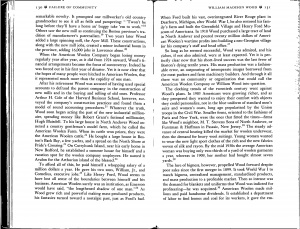Andover Biography - William Wood: Difference between revisions
No edit summary |
No edit summary |
||
| Line 31: | Line 31: | ||
--[[User:Eleanor|Eleanor]] 11:37, January 3, 2013 (EST)<br> | --[[User:Eleanor|Eleanor]] 11:37, January 3, 2013 (EST)<br> | ||
--[[User:Kim|Kim]] 11:36, January 17, 2013 (EST) | --[[User:Kim|Kim]] 11:36, January 17, 2013 (EST)<br> | ||
back to [[Main Page|Main Page]] | back to [[Main Page|Main Page]] | ||
[[Category:Andover Answers Index]] | [[Category:Andover Answers Index]] | ||
Revision as of 11:37, 17 January 2013
William Madison Wood was born in Edgartown on Martha's Vineyard on June 18, 1858, to immigrant parents from the Portuguese Azores. He had to go to work to support his family at age 13 when his father died. He began working in the New Bedford cotton mills and quickly rose through the ranks.
When Frederick Ayer asked Wood to save his unprofitable cotton mills, Wood came to Lawrence in 1886 as a manager at Washington Mill, but quickly was promoted to treasurer. Ayer then decided to convert mill production to wool. But the mills still were not profitable. Wood advocated combining mills to save costs and created the American Woolen Company - eight mills in Massachusetts, Rhode Island, and New York. After Wood became president of the American Woolen Company in 1899 it became the largest manufacturer of worsted wool in the world.
The Massachusetts Legislature reduced the work week was reduced from 56 to 54 hours in January of 1912. Wood reduced the workers' pay accordingly. This was the impetus for the Bread and Roses Strike in 1912.
After World War I Wood brought the American Woolen Company headquarters to Andover and changed the name of Frye Village to Shawsheen Village. Here he built a planned community consisting of brick homes for the high level managers, white wooden homes for the lower level managers, a school, recreational facilities including a golf course, a pool, and a club house. He even built a drug store.
A plaque on the corner of Lowell and North Main Streets is a tribute to Wood describing him as an "industrial genius", a "humanitarian", and a "great benefactor of youth". After several strokes, he took his life in 1926 at the age of 67 on February 2, 1926. Wood is buried in the West Parish Cemetery,
See
- Andover Stories: William Wood Andover's Horatio-Alger", Townsman, June 2, 2002.
- "Larsen Launches Discussion on Wood Memorial", Townsman, January 20, 2000, page 6.
- Mills, Mansions and Mergers: The Life of William M. Wood, by Edward G. Roddy
- "Mill Owner Led the World in Wool Manufacturing", Eagle Tribune, November 4, 1999, page 21
- "Wood: Andover Honors Controversial Figure", Eagle Tribune, Januart 13, 2000, page 1 and 2
The following pages are from:
- Province of Reason, by Sam Bass Warner, Jr.





--Eleanor 11:37, January 3, 2013 (EST)
--Kim 11:36, January 17, 2013 (EST)
back to Main Page